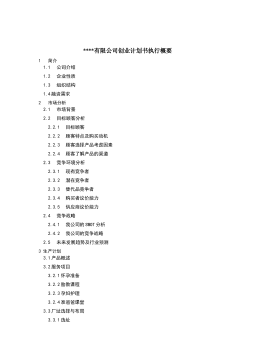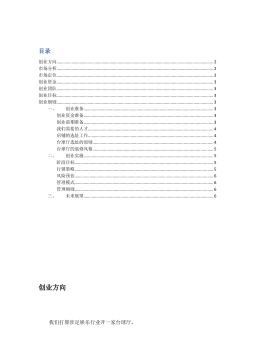USST_Arts_112060628浙江省产业内服务贸易竞争力研究
VIP免费
摘要
改革开放以来浙江依托沿海优势发展外向型经济,对外贸易取得显著发展,
尤其是“十二五”以来浙江省服务贸易表现突出,成为国民经济发展中最重要的
推动力量之一。服务贸易理论研究领域运用比较优势理论和竞争优势理论居多,
采用产业内贸易理论研究服务贸易的学者较少。产业内服务贸易代表先进服务贸
易的发展方向,在产业内贸易理论指引下改善浙江服务贸易国际竞争力和实现全
省服务经济持续稳定发展是浙江服务业发展的关键,并且对浙江省对外贸易结构
以及经济结构的转型都有着至关重要的影响。目前浙江省国际服务贸易的发展规
模、结构以及质量水平与北京、上海等服务贸易发达地区还有不少差距。因此,
系统的研究浙江产业内服务贸易,以此为切入点分析浙江省服务贸易发展中存在
的深层次问题,进而提出具体的建议措施,对提高浙江省国际服务贸易的竞争力
促进浙江服务贸易的可持续发展具有十分重要的现实意义。
本文在分析浙江服务贸易时依据产业内贸易理论的相关知识,运用定量分析
方法、定性分析方法、对比分析法和计量分析法,在数据分析中得出实际结论、
从对比中发现差距和潜力,通过计量分析解释了相关影响因子的影响程度。
本文依托产业内贸易理论研究浙江服务贸易发展中存在的问题,通过这一视
角分析和研究浙江省服务贸易的竞争力。绪论部分介绍了本文的研究背景、文献
综述、研究思路、基本方法和主要创新,界定了产业内服务贸易的研究意义。正
文包含五个部分。首先,对浙江省宏观经济情况以及进出口服务贸易的发展现状
进行梳理,得出浙江省服务贸易总量逐年提升表现出一定的竞争力,但服务行业
内部发展不平衡传统服务行业比重较大。其次,通过比较浙江与上海服务贸易国
际市场占有率、竞争优势指数、显示性比较优势指数、显示性竞争优势指数和净
出口显示性比较优势指数,得出浙江服务贸易的竞争优势总体弱于上海,但是劣
势有逐渐改善的趋势。再次,采用产业内贸易指标中的产业内贸易额、产业内贸
易指数、边际产业内贸易指数进行实证研究,分析得出浙江省最具竞争优势的服
务行业是传统服务贸易部门。接着,通过影响因子分析得出影响浙江省产业内服
务贸易发展的主要因素有人均 GDP、服务业增加值、服务业人力资源、服务贸易
不平衡程度、服务贸易开放程度。综上研究可得浙江省国际服务贸易发展迅速,
竞争力正在逐渐提高。从浙江服务贸易发展实情和产业内贸易理论出发,浙江省
初具竞争优势的服务部门是传统服务贸易部门。最后,为促进浙江服务贸易发展
需要从三个方面提出策略建议,包括宏观政府层面扩大服务业对外开放、培育服
务业人才储备、打造服务业综合聚集区;中观行业层面发展服务业规模经济、完
善服务业产业链建设;微观企业层面增强创新能力、建立自主品牌等,并提出浙
江服务业发展的合理路径和时间表。
关键词:服务贸易 浙江服务贸易 产业内贸易 竞争力分析
ABSTRACT
Since the rapid development of science and technology of twenty-first century,
profound changes in international trade already occurred. Trade in services gradually
raise the status in international trade, and become an important force in the economic
development of the region. Since the reform and opening up, with the help of coastal
location Zhejiang foreign trade develop rapidly, especially the service trade. In the past,
almost all the scholars adopt comparative advantage theory and competitive advantage
theory in theoretical research of international trade, instead of intra-industry trade theory.
However, Intra-industry trade representative the direction of modern service industry.
Promoting intra-industry trade is the key to enhance competitiveness of Zhejiang’s
service trade, also play an important role in changing the composition of trade of
Zhejiang. At present, there is huge gap in the scale, structure and quality of service trade
between Zhejiang and Shanghai Beijing. Therefore, the system research on the
intra-industry trade in services of Zhejiang province and analysis of the deep-seated
problems existing in the development of service trade in Zhejiang province, and then
put forward Specific advice measures has very important practical significance to
improve the competitiveness of the international trade in services and the sustainable
development of Zhejiang province.
In this paper, method of comparative analysis, quantitative analysis and
econometric are used to study the issues related Zhejiang service trade. Conclusions
could be found from the analysis of the practical data, the gap and potential could be
found from the contrast between Zhejiang and Shanghai, the influence of related factors
could be found through the econometric analysis.
This paper depends on the theory in Industry Trade to study Problems existing in
the development of service trade in Zhejiang province. By means of this perspective
analysis and research on the competitiveness of service trade in Zhejiang province. In
the part of introduction, the paper introduce the research background, literature review,
research approach, basic methods and the main innovation and also define the research
meaning of Intra-industry trade in services. The body of paper consists five parts, To
begin with, analysis the Macroeconomic situation and the development of Import and
export of service trade of Zhejiang, it could calculate that service trade volume increase
year by year and the total import and export average annual growth rate is greater than
the average annual GDP growth rate in Zhejiang. However, there is an unbalanced
development in the service industry. And them, by comparing the occupation rate of
international market, trade competitive index, revealed comparative advantage index
and net export revealed comparative advantage index between Zhejiang and Shanghai, it
could draw a conclusion that the Competitive advantage of service trade in Zhejiang is
weaker than Shanghai, but the disadvantages becoming narrow. Moreover, the paper
adopt the volume of intra-industry trade, intra-industry trade index and Marginal
intra-industry trade index to make empirical study, and concluded that the most
competitive service industry in Zhejiang is The traditional service trade sector like
transport service, tourism industry and construction and installation service. What’s
more, through the method of factor analysis, the paper find that per capita GDP, the
added value of service industry, human resources, imbalance of service trade, foreign
direct investment and service trade openness influence the development of
intra-industry trade in services in Zhejiang province. From the above, the paper
concludes that Zhejiang international service trade has developed rapidly, although the
market competitiveness is not strong, it’s improved year by year, and the most
competitive industry is the traditional service trade sector. The strategy to improve the
competitiveness of Zhejiang service trade include steadily opening service industries
wider to the outside world, cultivating service talent pool, creating comprehensive
service industry clusters, development of service industry economies of scale,
improving the services industry chain construction, strengthen the innovation ability, set
up independent brand. Only in this way could Zhejiang service trade have a bright
future.
Key words: Service Trade, Zhejiang Service Trade Intra-industry
Trade, Competitive Studies
目 录
摘要
ABSTRACT
第一章 绪论 ............................................................................................................ 1
1.1 课题的背景和意义 ....................................................................................... 1
1.1.1 现实背景 ................................................................................................ 1
1.1.2 理论背景 ................................................................................................ 1
1.1.3 理论意义 ................................................................................................ 3
1.1.4 现实意义 ................................................................................................ 4
1.2 文献综述 ....................................................................................................... 4
1.2.1 产业内贸易理论研究 ............................................................................ 4
1.2.2 浙江省服务贸易研究 ............................................................................ 6
1.2.3 产业内服务贸易研究 ............................................................................ 7
1.2.4 服务贸易竞争力研究 ............................................................................ 8
1.3 研究基本思路和方法 ................................................................................... 9
1.3.1 研究基本思路 ........................................................................................ 9
1.3.2 主要研究方法 ...................................................................................... 10
1.3.3 本文主要创新点 .................................................................................. 12
第二章 浙江服务业及服务贸易发展概况 .......................................................... 13
2.1 浙江经济发展现状 ..................................................................................... 13
2.1.1 浙江经济总量逐年增长 ...................................................................... 13
2.1.2 浙江服务业发展趋向合理 .................................................................. 14
2.2 浙江进出口贸易发展现状 ......................................................................... 16
2.2.1 浙江进出口贸易总量稳步提升 .......................................................... 16
2.2.2 浙江进出口市场分布 .......................................................................... 16
2.2.3 民间资本占据重要地位 ...................................................................... 17
2.3 浙江服务贸易发展现状 ............................................................................. 17
2.3.1 服务贸易进出口总量 .......................................................................... 17
2.3.2 服务贸易发展不平衡 .......................................................................... 19
2.4 浙江服务贸易分行业竞争力指标分析 ..................................................... 25
2.5 小结 ............................................................................................................. 27
第三章 浙沪服务贸易竞争力对比分析 .............................................................. 28
3.1 浙江服务贸易竞争力研究必要性 ............................................................. 28
3.2 竞争力指标对比分析 ................................................................................. 29
3.2.1 国际市场占有率对比 .......................................................................... 29
3.2.2 竞争优势指数对比 .............................................................................. 30
3.2.3 显示性比较优势指数对比 .................................................................. 30
3.2.4 显示性竞争优势指数对比 .................................................................. 31
3.2.5 净出口显示性比较优势指数对比 ...................................................... 32
3.3 小结 ............................................................................................................. 32
第四章 浙江产业内服务贸易指标分析 .............................................................. 33
4.1 产业内服务贸易指标度量分析 ................................................................. 33
4.2 浙江省产业内服务贸易额分析 ................................................................. 33
4.3 浙江产业内服务贸易指标测算分析 ......................................................... 36
4.3.1 浙江服务贸易 G-L 指标测算分析 ..................................................... 36
4.3.2 浙江服务贸易 MIIT 指数测算分析.................................................... 38
4.3.3 浙江服务贸易 HIIT 指数与 VIIT 指数测算分析 .............................. 40
4.4 小结 ............................................................................................................. 41
第五章 浙江产业内服务贸易影响因素分析 ...................................................... 42
5.1 影响因素的选择 ......................................................................................... 42
5.1.1 影响因素划分 ...................................................................................... 42
5.1.2 数据处理 .............................................................................................. 42
5.2 构建模型 ..................................................................................................... 44
5.3 实证检验与结果分析 ................................................................................. 46
5.4 结果分析 ..................................................................................................... 48
5.4.1 人均国内生产总值与差异化的服务产品需求呈正比 ...................... 48
5.4.2 规模经济促进产业间贸易的形成 ...................................................... 49
5.4.3 人力资本是产业内服务贸易的总要影响因素 .................................. 49
5.4.4 贸易不平衡程度制约产业内服务贸易的发展 .................................. 49
5.4.5 对外经济开放程度对产业内服务贸易影响程度加深 ...................... 49
5.4.6 外商直接投资替代效应明显 .............................................................. 50
5.5 小结 ............................................................................................................. 50
第六章 结论与策略建议 ...................................................................................... 51
6.1 研究结论 ..................................................................................................... 51
相关推荐
-
我国基层财政困难的制度成因分析与对策研究VIP免费
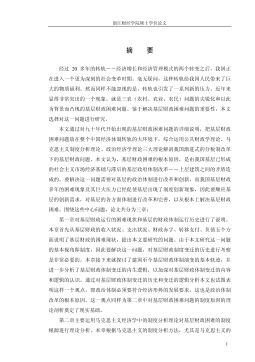
 2024-09-20 33
2024-09-20 33 -
我国煤电产业链纵向交易合约机制研究VIP免费
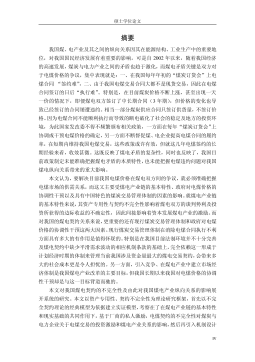
 2024-09-20 28
2024-09-20 28 -
生产要素视角下的上海市产业结构优化研究VIP免费
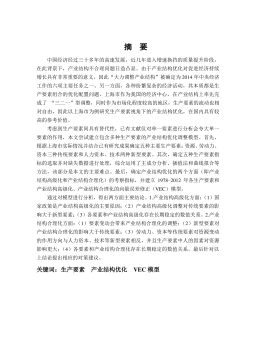
 2025-01-09 7
2025-01-09 7 -
我国银行业结构与经济结构关系研究VIP免费
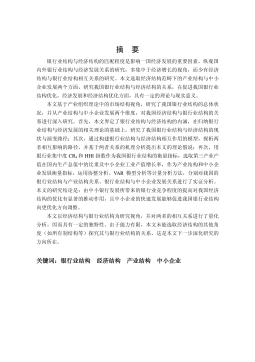
 2025-01-09 7
2025-01-09 7 -
大数据视角下农业供应链金融研究VIP免费

 2025-01-09 6
2025-01-09 6 -
跨国大型综合超市的规划研究VIP免费
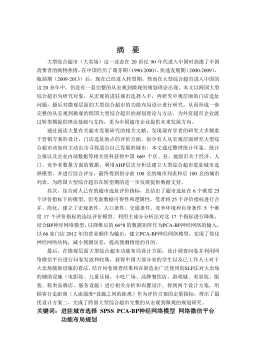
 2025-01-09 6
2025-01-09 6 -
跨境电商农产品质量安全问题研究VIP免费
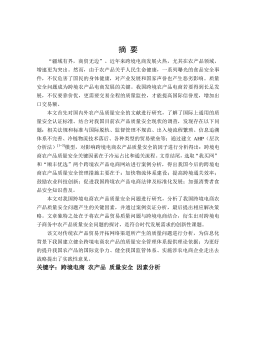
 2025-01-09 7
2025-01-09 7 -
世界市场的虚拟化与我国国际电子商务发展方向研究VIP免费
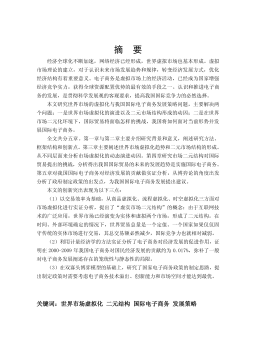
 2025-01-09 9
2025-01-09 9 -
中国政府对电力行业的价格规制问题研究VIP免费
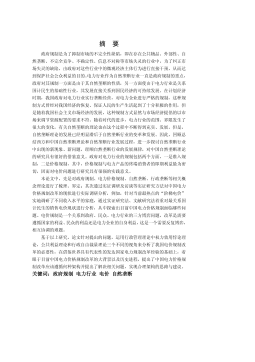
 2025-01-09 14
2025-01-09 14 -
中小企业信息化系统集成技术研究VIP免费
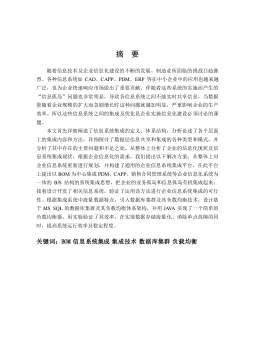
 2025-01-09 14
2025-01-09 14
作者:牛悦
分类:高等教育资料
价格:15积分
属性:68 页
大小:4.46MB
格式:PDF
时间:2025-01-09
相关内容
-

跨国大型综合超市的规划研究
分类:高等教育资料
时间:2025-01-09
标签:无
格式:PDF
价格:15 积分
-

跨境电商农产品质量安全问题研究
分类:高等教育资料
时间:2025-01-09
标签:无
格式:PDF
价格:15 积分
-

世界市场的虚拟化与我国国际电子商务发展方向研究
分类:高等教育资料
时间:2025-01-09
标签:无
格式:PDF
价格:15 积分
-

中国政府对电力行业的价格规制问题研究
分类:高等教育资料
时间:2025-01-09
标签:无
格式:PDF
价格:15 积分
-

中小企业信息化系统集成技术研究
分类:高等教育资料
时间:2025-01-09
标签:无
格式:PDF
价格:15 积分


